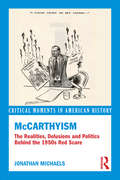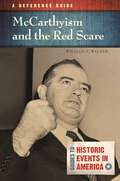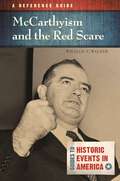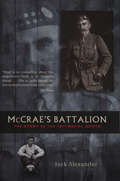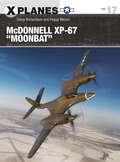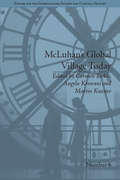- Table View
- List View
McCarthyism: The Realities, Delusions and Politics Behind the 1950s Red Scare (Critical Moments in American History)
by Jonathan MichaelsIn this succinct text, Jonathan Michaels examines the rise of anti-communist sentiment in the postwar United States, exploring the factors that facilitated McCarthyism and assessing the long-term effects on US politics and culture. McCarthyism:The Realities, Delusions and Politics Behind the 1950s Red Scare offers an analysis of the ways in which fear of communism manifested in daily American life, giving readers a rich understanding of this era of postwar American history. Including primary documents and a companion website, Michaels’ text presents a fully integrated picture of McCarthyism and the cultural climate of the United States in the aftermath of the Second World War.
McCarthyism: The Realities, Delusions and Politics Behind the 1950s Red Scare (Critical Moments in American History)
by Jonathan MichaelsIn this succinct text, Jonathan Michaels examines the rise of anti-communist sentiment in the postwar United States, exploring the factors that facilitated McCarthyism and assessing the long-term effects on US politics and culture. McCarthyism:The Realities, Delusions and Politics Behind the 1950s Red Scare offers an analysis of the ways in which fear of communism manifested in daily American life, giving readers a rich understanding of this era of postwar American history. Including primary documents and a companion website, Michaels’ text presents a fully integrated picture of McCarthyism and the cultural climate of the United States in the aftermath of the Second World War.
McCarthyism and the Red Scare: A Reference Guide (Guides to Historic Events in America)
by William T. WalkerThis book is a must-read for anyone studying and researching the rise and fall of Senator Joseph R. McCarthy and McCarthyism in American political life.Intolerance in America that targets alleged internal subversives controlled by external agents has a storied history that stretches hundreds of years. While the post-World War II "Red Scare" and the emergence of McCarthyism during the 1950s is the era commonly associated with American anticommunism, there was also a "First Red Scare" that occurred in 1919-1920. In both time periods, many Americans feared the radicalism of the left, and some of the most outspoken—like McCarthy—used slander to denounce their political enemies. The result was an atmosphere in which individual rights and liberties were at risk and hysteria prevailed.McCarthyism and the Red Scare: A Reference Guide tracks the rise and fall of Senator Joe McCarthy and the broad pursuit of domestic "Red" subversives in the post-World War II years, and focuses on how American society responded to real and perceived threats from the left during the first decade of the Cold War.
McCarthyism and the Red Scare: A Reference Guide (Guides to Historic Events in America)
by William T. WalkerThis book is a must-read for anyone studying and researching the rise and fall of Senator Joseph R. McCarthy and McCarthyism in American political life.Intolerance in America that targets alleged internal subversives controlled by external agents has a storied history that stretches hundreds of years. While the post-World War II "Red Scare" and the emergence of McCarthyism during the 1950s is the era commonly associated with American anticommunism, there was also a "First Red Scare" that occurred in 1919-1920. In both time periods, many Americans feared the radicalism of the left, and some of the most outspoken—like McCarthy—used slander to denounce their political enemies. The result was an atmosphere in which individual rights and liberties were at risk and hysteria prevailed.McCarthyism and the Red Scare: A Reference Guide tracks the rise and fall of Senator Joe McCarthy and the broad pursuit of domestic "Red" subversives in the post-World War II years, and focuses on how American society responded to real and perceived threats from the left during the first decade of the Cold War.
McCarthy's Americans: Red Scare Politics in State and Nation, 1935-1965 (American History in Depth)
by M.J. HealeWas the communist witch hunt unleashed by Senator Joe McCarthy an aberration, or has red scare politics been an intrinsic part of American political life since the 1930s? Was McCarthyism a populist or an elitist phenomenon? Was Senator McCarthy virtually irrelevant to the phenomenon? This book shows that some of the contending interpretations of McCarthyism are mutually compatible and reveals the importance of pressures usually overlooked. Professor Heale's deeply-probing study of Joe McCarthy's 'hinterland' in the American states, demonstrates that what is usually called McCarthyism was part of a political cycle, that emerged in the 1930s and took two decades to run its course.
McCormick of Rutgers: Scholar, Teacher, Public Historian (Studies in Historiography)
by Michael J. BirknerRichard P. McCormick made his mark as an innovative student of American party politics, as well as the most influential interpreter of New Jersey history. A distinguished teacher, scholar, and public historian, McCormick revitalized a venerable but dormant state historical society. Later, he used notable anniversaries, such as the Bicentennial of the American Revolution and the Tercentenary of New Jersey's founding, as vehicles to bring history to schools and the general public. He also helped create a state historical agency, the New Jersey Historical Commission, to promote New Jersey's past and preserve its historic treasures.Birkner describes McCormick's life and times. He looks at McCormick's scholarly apprenticeship, the origins of his interest in a new political history, and his contributions to the study of American politics before the Civil War. McCormick's concern for elucidating political machinery was fused with a fundamental skepticism about American democracy as run by and for the people. Through use of oral history, McCormick tells his own story. Then, through their exchanges, Birkner challenges some of McCormick's scholarly arguments and elicits responses that help to shed light on his subject's theory of politics.
McCrae's Battalion: The Story of the 16th Royal Scots
by Jack AlexanderMcCrae's Own was the 'Heart of Midlothian Battalion' mentioned all too briefly in Martin Middlebrook's classic book The First Day on the Somme. Raised in Edinburgh shortly after the start of the Great War, it was perhaps the finest unit in Lord Kitchener's volunteer army - a brotherhood of sportsmen, bound together by their extraordinary colonel and their loyalty to a quaintly named Association Football club, the famous Gorgie 'Hearts'. McCrae's were blooded in the Battle of the Somme, losing three-quarters of their strength on the first day alone. The Colonel himself was invalided home. In time the battalion recovered. It came of age at Arras, endured the muddy horror of Passchendaele, and held the line unbroken in the face of furious German attacks on the Lys in 1918. For almost a century their story remained untold. It was all but lost forever. Now, after 12 years of exacting historical detective work, Jack Alexander has reclaimed the 16th Royal Scots for posterity. In this stirring book he draws upon interviews with veterans and a unique archive of letters, diaries and photographs, assembled from the families of more than 1,000 of Sir George McCrae's men.
McDonnell Douglas Phantom- Two-Seat All-weather Interceptor and Ground-attack Fighter (large print)
by RnibThis is an image of a jet fighter aircraft seen from above. There is a locator dot shown, which will be at the top left of the page when the image is the correct way up. The image is in the centre and a scale in metres on the left of the page. The aircraft nose is in the top centre and the tail in the bottom centre of the page. The fuselage goes up and down the middle of the page. The cockpit cover is shown as an oval near the nose. There is the intake of a jet engine to the left and right of the cockpit. The wings sweep down to the left and right. The wings each have one fuel tank sticking out on the front edge and two ailerons on the rear edge. These are the ailerons used to manoeuvre the aircraft when it is flying. At the bottom of the page in the centre of the fuselage is the vertical tail. To each side of this is the tailplane. Just up from the tailplane, to the left and right, are the jet exhaust nozzles.
McDonnell Douglas Phantom- Two-Seat All-weather Interceptor and Ground-attack Fighter (UEB contracted)
by RnibThis is an image of a jet fighter aircraft seen from above. There is a locator dot shown, which will be at the top left of the page when the image is the correct way up. The image is in the centre and a scale in metres on the left of the page. The aircraft nose is in the top centre and the tail in the bottom centre of the page. The fuselage goes up and down the middle of the page. The cockpit cover is shown as an oval near the nose. There is the intake of a jet engine to the left and right of the cockpit. The wings sweep down to the left and right. The wings each have one fuel tank sticking out on the front edge and two ailerons on the rear edge. These are the ailerons used to manoeuvre the aircraft when it is flying. At the bottom of the page in the centre of the fuselage is the vertical tail. To each side of this is the tailplane. Just up from the tailplane, to the left and right, are the jet exhaust nozzles.
McDonnell Douglas Phantom- Two-Seat All-weather Interceptor and Ground-attack Fighter (UEB uncontracted)
by RnibThis is an image of a jet fighter aircraft seen from above. There is a locator dot shown, which will be at the top left of the page when the image is the correct way up. The image is in the centre and a scale in metres on the left of the page. The aircraft nose is in the top centre and the tail in the bottom centre of the page. The fuselage goes up and down the middle of the page. The cockpit cover is shown as an oval near the nose. There is the intake of a jet engine to the left and right of the cockpit. The wings sweep down to the left and right. The wings each have one fuel tank sticking out on the front edge and two ailerons on the rear edge. These are the ailerons used to manoeuvre the aircraft when it is flying. At the bottom of the page in the centre of the fuselage is the vertical tail. To each side of this is the tailplane. Just up from the tailplane, to the left and right, are the jet exhaust nozzles.
McDonnell XP-67 "Moonbat" (X-Planes)
by Steve Richardson Peggy MasonPacked with never-before-seen photos, plans and meticulous new digital artwork, this is the first history of the USAAF's futuristic World War II prototype interceptor, the XP-67 "Moonbat".The series of X-planes that sprang from the US Army's Request for Data R40C, focused on high-altitude, high-speed, long-range bomber interceptors. Among these aircraft was the McDonnell Aircraft Company's first ever clean sheet design, the XP67. Its futuristic lines promised performance that it was ultimately unable to deliver, but development was still underway when disaster struck. Just before Army performance demonstration flights were scheduled to begin, an engine fire destroyed the only XP-67 prototype, leaving a host of unanswered questions about what might have been, and leading to decades of continuing fascination with the XP-67 among aviation buffs and aircraft modelers.The authors of this book have uncovered new sources of information and a wealth of photographs and line drawings that document not just the XP-67 but also its immediate precursors within the McDonnell Aircraft design community, as well as alternative configurations for unbuilt variants aimed at different missions. Packed with unpublished photos of all stages of construction including key airframe changes made after initial flight tests, showing in detail how the final configuration was evolved, this volume finally provides clear focus on a story that has long been shrouded in mystery.
McDonnell XP-67 "Moonbat" (X-Planes)
by Steve Richardson Peggy MasonPacked with never-before-seen photos, plans and meticulous new digital artwork, this is the first history of the USAAF's futuristic World War II prototype interceptor, the XP-67 "Moonbat".The series of X-planes that sprang from the US Army's Request for Data R40C, focused on high-altitude, high-speed, long-range bomber interceptors. Among these aircraft was the McDonnell Aircraft Company's first ever clean sheet design, the XP67. Its futuristic lines promised performance that it was ultimately unable to deliver, but development was still underway when disaster struck. Just before Army performance demonstration flights were scheduled to begin, an engine fire destroyed the only XP-67 prototype, leaving a host of unanswered questions about what might have been, and leading to decades of continuing fascination with the XP-67 among aviation buffs and aircraft modelers.The authors of this book have uncovered new sources of information and a wealth of photographs and line drawings that document not just the XP-67 but also its immediate precursors within the McDonnell Aircraft design community, as well as alternative configurations for unbuilt variants aimed at different missions. Packed with unpublished photos of all stages of construction including key airframe changes made after initial flight tests, showing in detail how the final configuration was evolved, this volume finally provides clear focus on a story that has long been shrouded in mystery.
McDowell and Hegel: Perceptual Experience, Thought and Action (Studies in German Idealism #20)
by Federico Sanguinetti André J. AbathThis book presents a comprehensive and detailed exploration of the relationship between the thought of G.W.F. Hegel and that of John McDowell, the latter of whom is widely considered to be one of the most influential living analytic philosophers. It serves as a point of entry in McDowell’s and Hegel’s philosophy, and a substantial contribution to ongoing debates on perceptual experience and perceptual justification, naturalism, human freedom and action. The chapters gathered in this volume, as well as McDowell’s responses, make it clear that McDowell’s work paves the way for an original reading of Hegel’s texts. His conceptual framework allows for new interpretive possibilities in Hegel’s philosophy which, until now, have remained largely unexplored. Moreover, these interpretations shed light on various aspects of continuity and discontinuity between the philosophies of these two authors, thus defining more clearly their positions on specific issues. In addition, they allow us to see Hegel’s thought as containing a number of conceptual tools that might be useful for advancing McDowell’s own philosophy and contemporary philosophy in general.
McDowell and His Critics (Philosophers and their Critics #9)
by Cynthia Macdonald Graham MacDonaldThe most comprehensive discussion available of the work of philosopher, John McDowell. Contains newly commissioned papers by distinguished philosophers on McDowell’s work, along with substantial replies to each by McDowell himself. The contributors are philosophers with international reputations for their work in the areas in which they are contributing. Covers the whole of McDowell’s philosophy, including his contributions in ancient philosophy, moral philosophy, philosophy of mind, philosophy of language, metaphysics and epistemology. McDowell’s replies to the contributions in this volume contribute to the body of his work.
McDowell and the Hermeneutic Tradition (Routledge Studies in American Philosophy)
by Daniel Martin Feige Thomas J. SpiegelThis volume explores the connections between John McDowell’s philosophy and the hermeneutic tradition. The contributions not only explore the hermeneutical aspects of McDowell’s thought but also ask how this reading of McDowell can inform the hermeneutical tradition itself. John McDowell has made important contributions to debates in epistemology, metaethics, and philosophy of language, and his readings of Aristotle, Kant, Hegel, and Wittgenstein have proved widely infl uential. While there are instances in which McDowell draws upon the work of hermeneutic thinkers, the hermeneutic strand of McDowell’s philosophy has not yet been systematically explored in depth. The chapters in this volume open up a space in which to read McDowell himself as a hermeneutic thinker. They address several research questions: How can McDowell’s recourse to the hermeneutical tradition be understood in detail? Besides Gadamer, does McDowell’s work implicitly convey and advance motives from other seminal fi gures of this tradition, such as Heidegger and Dilthey? Are there aspects of McDowell’s position that can be enhanced through a juxtaposition with central hermeneutic concepts like World, Tradition, and Understanding? Are there further, perhaps yet unexplored aspects of McDowell’s infl uences that ought to be interpreted as expressing hermeneutic ideas? McDowell and the Hermeneutic Tradition will appeal to researchers and advanced students working in American philosophy, Continental philosophy, hermeneutics, history of philosophy, philosophy of language, and epistemology.
McDowell and the Hermeneutic Tradition (Routledge Studies in American Philosophy)
This volume explores the connections between John McDowell’s philosophy and the hermeneutic tradition. The contributions not only explore the hermeneutical aspects of McDowell’s thought but also ask how this reading of McDowell can inform the hermeneutical tradition itself. John McDowell has made important contributions to debates in epistemology, metaethics, and philosophy of language, and his readings of Aristotle, Kant, Hegel, and Wittgenstein have proved widely infl uential. While there are instances in which McDowell draws upon the work of hermeneutic thinkers, the hermeneutic strand of McDowell’s philosophy has not yet been systematically explored in depth. The chapters in this volume open up a space in which to read McDowell himself as a hermeneutic thinker. They address several research questions: How can McDowell’s recourse to the hermeneutical tradition be understood in detail? Besides Gadamer, does McDowell’s work implicitly convey and advance motives from other seminal fi gures of this tradition, such as Heidegger and Dilthey? Are there aspects of McDowell’s position that can be enhanced through a juxtaposition with central hermeneutic concepts like World, Tradition, and Understanding? Are there further, perhaps yet unexplored aspects of McDowell’s infl uences that ought to be interpreted as expressing hermeneutic ideas? McDowell and the Hermeneutic Tradition will appeal to researchers and advanced students working in American philosophy, Continental philosophy, hermeneutics, history of philosophy, philosophy of language, and epistemology.
McGlue: From the author of TikTok sensations My Year of Rest and Relaxation and Lapvona (The\fence Modern Prize In Prose Ser.)
by Ottessa MoshfeghDive into the extended Ottessa Moshfegh universe with a special edition of McGlue, the novel that catapulted Moshfegh to literary stardom'One of America's most exciting - and most provocative - young novelists' Financial Times'You’re in safe, if sticky hands... A wild ride' The TimesSomewhere in the Indian Ocean, 1851: McGlue is down in the hold, still too drunk to be sure of his name, situation or orientation – but he has blood on his hands. He may have killed a man. That man may have been his best friend. As the ship makes its voyage home to Salem, Massachusetts, intolerable memory accompanies reluctant sobriety.A-sail on the high seas of literary tradition, Ottessa Moshfegh gives us a nasty heartless blackguard on a knife-sharp voyage through the fogs of recollection.
McKay's Bees: A Novel (Phoenix Fiction)
by Thomas McMahonMoving from Massachusetts to Kansas in 1855 with his new wife and a group of German carpenters, Gordon McKay is dead set on making his fortune raising bees—undaunted by Missouri border ruffians, newly-minted Darwinism, or the unsettled politics of a country on the brink of civil war.
McKay's Bees: A Novel (Phoenix Fiction)
by Thomas McMahonMoving from Massachusetts to Kansas in 1855 with his new wife and a group of German carpenters, Gordon McKay is dead set on making his fortune raising bees—undaunted by Missouri border ruffians, newly-minted Darwinism, or the unsettled politics of a country on the brink of civil war.
McKay's Bees: A Novel (Phoenix Fiction)
by Thomas McMahonMoving from Massachusetts to Kansas in 1855 with his new wife and a group of German carpenters, Gordon McKay is dead set on making his fortune raising bees—undaunted by Missouri border ruffians, newly-minted Darwinism, or the unsettled politics of a country on the brink of civil war.
McKay's Bees: A Novel (Phoenix Fiction)
by Thomas McMahonMoving from Massachusetts to Kansas in 1855 with his new wife and a group of German carpenters, Gordon McKay is dead set on making his fortune raising bees—undaunted by Missouri border ruffians, newly-minted Darwinism, or the unsettled politics of a country on the brink of civil war.
McLuhan's Global Village Today: Transatlantic Perspectives (Studies for the International Society for Cultural History)
by Angela KrewaniMarshall McLuhan was one of the leading media theorists of the twentieth century. This collection of essays explores the many facets of McLuhan’s work from a transatlantic perspective, balancing applied case studies with theoretical discussions.
McLuhan's Global Village Today: Transatlantic Perspectives (Studies for the International Society for Cultural History #6)
by Angela KrewaniMarshall McLuhan was one of the leading media theorists of the twentieth century. This collection of essays explores the many facets of McLuhan’s work from a transatlantic perspective, balancing applied case studies with theoretical discussions.
McMafia: Seriously Organised Crime
by Misha GlennyThe extraordinary real stories that inspired the major BBC series Have you ever illegally downloaded a DVD? Taken drugs? Fallen for a phishing scam?Organised crime is part of all our worlds - often without us even knowing. McMafia is a journey through the new world of international organised crime, from gunrunners in Ukraine to money launderers in Dubai, by way of drug syndicates in Canada and cyber criminals in Brazil.This edition comes with a new introduction and epilogue from author Misha Glenny.
McMafia Brain Shot
by Misha GlennyIn this powerful account, Misha Glenny takes us on a journey through the new world of international organised crime. He has travelled throughout the world - from Japan to China to Brazil to the USA and has spoken to countless gangsters, policemen and victims of organised crime while also exploring the ferocious consumer demand for drugs, trafficked women, illegal labour and arms across five continents.McMafia Brain Shot focuses on cybercrime in Brazil and people trafficking from China to Brazil, the UK and Europe and unpicks the nexus of crime, politics and money worldwide which have become entangled and interdependent in entirely novel forms since the 1980s. It argues that conventional policing methods are no longer appropriate to deal with a problem whose roots lie in global poverty and the ever widening divisions between rich and poor.BRAIN SHOTS: The byte-sized account of international crime and globalisation's dark side
